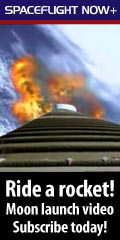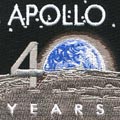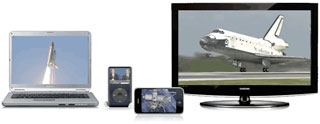 Orbiter: Atlantis Mission: STS-129 Payload: ISS ULF 3 Launch: Nov. 16, 2009 Time: 2:28 p.m. EST Site: Pad 39A, Kennedy Space Center Landing: Nov. 27 @ approx. 9:45 a.m. Site: KSC's Shuttle Landing Facility 

|
Mission Status Center
Welcome to Spaceflight Now's live coverage of space shuttle Atlantis' STS-129 mission to the International Space Station. Text updates will appear automatically; there is no need to reload the page. HD VIDEO | STANDARD VIDEO | LAUNCH WINDOWS | FLIGHT PLAN WEDNESDAY, NOVEMBER 25, 2009
The Orbiter Boom Sensor System has been berthed in the payload bay, its job complete for the mission. Analysts on the ground will be examining all of the imagery gathered and should have the heat shield cleared of any concern by tomorrow.
1848 GMT (1:48 p.m. EST) 1819 GMT (1:19 p.m. EST)
The surveys are finished, and the crew is returning the inspection boom to its cradle in the payload bay.
1753 GMT (12:53 p.m. EST)
Running basically on the timeline, observations of the port wing are continuing aboard shuttle Atlantis. This is the third and final part of the inspections for today.
1648 GMT (11:48 a.m. EST)
After taking a few minutes to use the boom cameras and check the dump nozzle on the side of Atlantis, the heat shield inspections of the port wing are getting underway. During a waste water dump earlier this morning, an apparent clog prevented the shuttle's storage tank from being emptied completely. This examination of the nozzle confirms there's no external ice buildup. Engineers suspect the problem is somewhere in the internal plumbing.
1625 GMT (11:25 a.m. EST)
Inspections of the reinforced carbon-carbon nose cap of the shuttle are complete.
1540 GMT (10:40 a.m. EST)
The right wing has been scanned using the laser and camera package of the Orbiter Boom Sensor System. The crew is swinging the boom in position to inspect Atlantis' nose cap next.
1505 GMT (10:05 a.m. EST)
These inspections are similar to the ones performed the day after launch. Today's survey results will be compared with the earlier data to ensure the orbiter's wing leading edge panels and nose cap are free of any space debris impacts that could have occurred during the mission.
1400 GMT (9:00 a.m. EST)
Atlantis' robot arm has grappled the Orbiter Boom Sensor System and lifted the 50-foot-long inspection tool out of the payload bay for today's heat shield inspections that will begin with the starboard wing's RCC panels.
1133 GMT (6:33 a.m. EST)
The shuttle is quickly departing the vicinity of the space station following separation burn No. 2.
The astronauts will spend the rest of their workday using the Orbiter Boom Sensor System to inspect the shuttle's wing leading edge panels and nose cap to look for any space debris or micrometeoroid damage that could have occurred during the mission. Standard day-before-landing tests of Atlantis' flight controls and thrusters, along with packing up the cabin for entry will fill the crew's Thanksgiving in orbit. Landing at the Kennedy Space Center on Runway 33 to conclude this spaceflight is scheduled for Friday at 9:44 a.m. EST. The early weather forecast appears favorable. Here's a look at the landing times for Friday, Saturday, Sunday and Monday at KSC and Edwards Air Force Base, California: (all times EST) ORBIT....SITE.....DEORBIT....LANDING Friday, Nov. 27 171......KSC......08:41 AM...09:44 AM 172......KSC......10:16 AM...11:19 AM Saturday, Nov. 28 187......KSC......08:56 AM...09:59 AM 188......EDW......10:25 AM...11:29 AM .........KSC......10:33 AM...11:34 AM* 189......EDW......12:01 PM...01:03 PM 190......EDW......01:38 PM...02:38 PM Sunday, Nov. 29 202......KSC......07:34 AM...08:38 AM 203......KSC......09:09 AM...10:12 AM 204......EDW......10:38 AM...11:42 AM 205......EDW......12:14 PM...01:16 PM Monday, Nov. 30: 218......KSC......07:47 AM...08:51 AM 219......KSC......09:23 AM...10:26 AM 220......EDW......10:52 AM...11:55 AM 221......EDW......12:28 PM...01:30 PM *Orbit adjust burn required 1128 GMT (6:28 a.m. EST)
Now about a mile of separation beween the two craft as Atlantis moves away at five feet per second.
1120 GMT (6:20 a.m. EST)
The space shuttle is climbing high above and behind the station.
1111 GMT (6:11 a.m. EST)
Atlantis now more than 1,000 feet above the station.
1104 GMT (6:04 a.m. EST)
The shuttle just performed the first of two separation engine firings. This brief burn changed Atlantis' speed by about 1.5 feet per second.
1103 GMT (6:03 a.m. EST)
Atlantis is back out in front of the International Space Station to complete its full victory lap.
1051 GMT (5:51 a.m. EST)
The shuttle is beneath the station now, continuing its circle around the complex.
1042 GMT (5:42 a.m. EST)
Atlantis is nearing a point directly behind the station in terms of the direction of travel of the two spacecraft around the Earth, which is known as the -V bar.
1037 GMT (5:37 a.m. EST)
Distance between the two craft has grown to 625 feet.
1030 GMT (5:30 a.m. EST)
Atlantis is reaching a point more than 500 feet directly above the space station.
The flyaround started with the shuttle in front of the station. It takes Atlantis to a point directly above the complex, then behind it, looping below and back out in front. After climbing above the station for a second time, the final separation engine firing will be performed. This burn will send Atlantis away from the vicinity of the station. 1024 GMT (5:24 a.m. EST)
Atlantis is 468 feet away from the station.
1018 GMT (5:18 a.m. EST)
Pilot Butch Wilmore has begun flying Atlantis in a one-lap flyaround of the station.
1016 GMT (5:16 a.m. EST)
The docking mechanism in Atlantis' payload bay has been powered down.
1015 GMT (5:15 a.m. EST)
Atlantis currently 370 feet away from the station, continuing to separate at 0.22 feet per second.
1012 GMT (5:12 a.m. EST)
The shuttle is headed to a point more than 400 feet away where it will fire thrusters to begin an arc above the station for today's flyaround.
1011 GMT (5:11 a.m. EST)
The spacecraft are flying into an orbital sunrise.
1008 GMT (5:08 a.m. EST)
Atlantis is 200 feet from the station.
1001 GMT (5:01 a.m. EST)
Now 100 feet of separation with Atlantis moving away at 0.2 feet per second.
0958 GMT (4:58 a.m. EST)
Atlantis is 65 feet from the station as it slowly backs away.
0954 GMT (4:54 a.m. EST)
The undocking occurred on time as the two spacecraft flew 216 miles over the Pacific near Indonesia.
0953 GMT (4:53 a.m. EST)
UNDOCKING! Atlantis and the International Space Station are parting company after 6 days, 17 hours and 2 minutes of being linked together high above Earth for a visit that delivered two large pallets of spare parts meant to keep the outpost flying for many years to come.
Atlantis is due home at the Kennedy Space Center on Friday morning at 9:44 a.m. EST. 0952 GMT (4:52 a.m. EST)
Hooks and latches are driving open.
0948 GMT (4:48 a.m. EST)
Five minutes from undocking. The steering jets on Atlantis are inhibited for the period of physical undocking from the station. The separation occurs when large springs push the two craft apart. Once the shuttle is a couple feet away from the station and the docking devices are clear of one another, pilot Butch Wilmore will fire Atlantis' thrusters to continue the movement away.
0945 GMT (4:45 a.m. EST)
The spacecraft are passing into an orbital sunset. The undocking will occur in darkness but the later flyaround of the station by Atlantis will take place in daylight.
0937 GMT (4:37 a.m. EST)
The "go" for undocking has been radioed to the shuttle astronauts from Houston.
0920 GMT (4:20 a.m. EST)
The docking mechanism in Atlantis' payload bay is being powered up.
0910 GMT (4:10 a.m. EST)
The Atlantis astronauts are gearing up to undock from the International Space Station today at 4:53 a.m. EST. Pilot Barry Wilmore will carry out a 360-degree photo-documentation fly-around before departing the area just after 6:30 a.m.
Read our full story. 0900 GMT (4:00 a.m. EST)
Both the shuttle and station flight control teams report all systems are ready for the undocking at 4:53 a.m. EST. Atlantis' guidance system was aligned this morning, the entire shuttle/station complex was reoriented to the proper attitude for undocking and the station's giant solar arrays have been positioned to protect them from shuttle thruster plumes.
0840 GMT (3:40 a.m. EST)
Throughout the time Atlantis has been docked to the space station, the combined stack flew in an orientation with the Russian segment leading the way. This was meant to keep Atlantis' heat shield out of the direction of travel. But as undocking approaches, the stack has been turned 180 degrees to enable Atlantis to separate and fly out in front of the station, reversing its path to docking a week ago.
0629 GMT (1:29 a.m. EST)
The astronauts have been awakened for Flight Day 10, which will see the space shuttle Atlantis leave the International Space Station after its successful docked mission there. The shuttle is scheduled to depart at 4:53 a.m. EST and perform a one-lap flyaround of the complex before soaring away this morning.
WEDNESDAY, NOVEMBER 24, 2009
The Atlantis astronauts used the shuttle's maneuvering thrusters to boost the International Space Station's altitude by more than a mile early Tuesday, participated in a change-of-command ceremony aboard the lab complex and then bid their station colleagues farewell before closing hatches to set the stage for undocking Wednesday.
1835 GMT (1:35 p.m. EST) Read our full story. 1820 GMT (1:20 p.m. EST)
Hatch closure was called complete at 1:12 p.m. EST, completing five days, 23 hours and 44 minutes of joint time between Atlantis and the station crews.
1740 GMT (12:40 p.m. EST)
The shuttle and station crews are gathering in the Harmony module for a farewell ceremony. The Atlantis astronauts will be heading back to the orbiter and closing the hatchway in preparation for tomorrow's undocking.
The flight plan calls for the shuttlte crew to spend the night on their own spacecraft with the hatches already shut so that when wakeup occurs tomorrow they can get right into the departure activities. It will be a busy day, not only with undocking just before 5 a.m. EST but also a final round of heat shield inspections tomorrow, setting the stage for pre-landing system testing on Thanksgiving Day and Atlantis' return to Earth on Friday. 1503 GMT (10:03 a.m. EST)
A change of command ceremony is underway aboard the Destiny laboratory of the International Space Station as Expedition 21 commander Frank De Winne of the European Space Agency hands control of the outpost to Expedition 22 skipper Jeff Williams of NASA.
De Winne was the first European commander of the space station. He will return to Earth in a Soyuz spacecraft next Monday night with Russian cosmonaut Roman Romanenko and Canadian astronaut Robert Thirsk. 1205 GMT (7:05 a.m. EST)
The Atlantis astronauts used the shuttle's maneuvering thrusters to boost the International Space Station's altitude by nearly one mile early Tuesday, before a traditional joint crew news conference at 8 a.m. EST and few hours of off duty time.
Read our full story. 1009 GMT (5:09 a.m. EST)
Reaction control system thrusters on space shuttle Atlantis are firing to boost the International Space Station into a slightly higher orbit. This 27-minute maneuver is designed to change the station's velocity by 2.5 feet per second and raise the orbit by about nine-tenths of a mile (1.5 km).
0658 GMT (1:58 a.m. EST)
The Atlantis astronauts have been awakened for their last full day docked at the International Space Station.
Activities on the agenda for today include a small reboost of the station's orbit by the space shuttle, some off-duty time for the Atlantis crew, then the farewell ceremony and hatch closure in preparation for Wednesday morning's departure. 0655 GMT (1:55 a.m. EST)
The latest version of the NASA Television schedule (Rev. L) can be downloaded here.
Read our earlier status center coverage. |
 The astronauts launching on Atlantis: Leland Melvin, commander Charlie Hobaugh, Mike Foreman, Robert Satcher, pilot Barry Wilmore and Randy Bresnik.  Photo galleries: Space shuttle Atlantis readied for its next mission to the International Space Station: Move from hangar to VAB | Rollout to pad 39A 
Space video for your computer, iPod or big screen TV
Experience the space program like never before become a subscriber today |